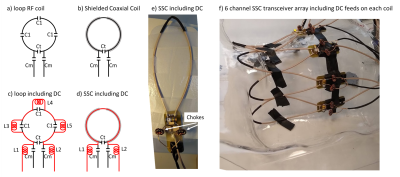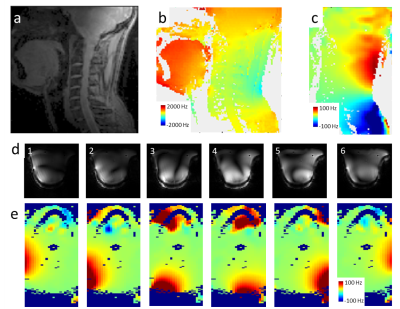3109
Shielded coaxial cable coils for transmit, receive and B0 shimming in a 7T neck array
Vincent O. Boer1, Jan Ole Pedersen2, Hørður Andreasen3, Sadri Güler1,4, Vitaliy Zhurbenko3, Jason Stockmann5, Irena Zivkovic6, and Esben Thade Petersen1,4
1Danish Research Centre for Magnetic Resonance, Centre for Functional and Diagnostic Imaging and Research, Copenhagen University Hospital, Hvidovre, Denmark, 2Philips Healthcare, Copenhagen, Denmark, 3Department of Electrical Engineering, Technical University of Denmark, Kongens Lyngby, Denmark, 4Section for Magnetic Resonance, DTU Health Tech, Technical University of Denmark, Kongens Lyngby, Denmark, 5Athinoula A Martinos Center for Biomedical Imaging, Department of Radiology, Massachusetts General Hospital, Charlestown, MA, United States, 6Electrical Engineering department, Technical University of Eindhoven, Eindhoven, Netherlands
1Danish Research Centre for Magnetic Resonance, Centre for Functional and Diagnostic Imaging and Research, Copenhagen University Hospital, Hvidovre, Denmark, 2Philips Healthcare, Copenhagen, Denmark, 3Department of Electrical Engineering, Technical University of Denmark, Kongens Lyngby, Denmark, 4Section for Magnetic Resonance, DTU Health Tech, Technical University of Denmark, Kongens Lyngby, Denmark, 5Athinoula A Martinos Center for Biomedical Imaging, Department of Radiology, Massachusetts General Hospital, Charlestown, MA, United States, 6Electrical Engineering department, Technical University of Eindhoven, Eindhoven, Netherlands
Synopsis
Shielded coaxial RF coils show very low coupling between elements, and are ideal for building transmit-receive arrays. In this work we extended a 6 element transceive array with B0 shim capabilities.
Introduction
Spinal cord MRI at 7T has emerged recently as a field of research, which hold large promise for spinal cord injury and brain-spine exams [1]. For field sensitive sequences (e.g. T2*, fMRI, spectroscopy) the inhomogeneous B0 field presents a challenge for image encoding and lipid suppression, especially at ultra-high field. Slice based shimming has been proposed as a solution for multi-slice sequence [2]. Further, breathing induced shim variations are large in the spine compared to the brain [3].The extension of the shim system with addition of local shim coils [4,5] seems to be a promising development, as such coils facilitate improving the B0 field homogeneity through static, dynamic slice optimized, and even breathing compensated real-time shimming. This is feasible as these small coils typically induce low induced eddy currents. However, integration of additional B0 shim coils with the RF transmit and receive system is cumbersome due to limited space and potential coupling or shielding.
Recently, shielded self-resonant coaxial coils were proposed as an alternative to traditional loop coils [6]. They rely on distributed reactance of the coaxial cable, which makes them highly suited to be used in flexible transmit-receive arrays. Furthermore, the single shielded conductor is not broken up by capacitors, making them ideal candidates for an extension with B0 shim capabilities. Here we show the design of a transmit-receive and B0 shim array for the human neck at ultra-high field.
Methods
Shielded coaxial coils were constructed as described in [3] and extended with two toroidal RF chokes [7] over the tuning capacitor (figure 1d/e) to enable DC supply to the loop. The RF chokes were built from a 3D printed 14 mm diameter ‘donut’ and wound by 15 turns of AWG22 wire to construct an effective RF blockage, which preserves the RF coil transmit and receive capabilities after adding the DC current path. Both a reflection (|S11|) measurement and B1 mapping (DREAM) was performed to verify that the RF coil performance was not affected by the additional components.Six of such SCC coils (figure 1f) were mounted without overlap on a neck former, based on Cohen-Adad et al [5]. The shape was adapted in 3D modeling software (freeware - www.blender.org) to fit the Duke human body model, and manufactured by vacuum forming a 3 mm acrylic (PMMA) sheet on to a wooden neck rest plug.
The RF coils were interfaced to a 7T multi-transmit MR system (Philips Achieva, Best, The Netherlands), and the DC connection was interfaced to a multi-channel open-source current driver [8] which allowed for +/- 2.5A current drive and short switching times without measurable eddy currents when testing for dynamic applications.
The shim fields were calibrated on a large water balloon (added 4g/L salt) that covered the area where the human neck would be placed, using B0 field mapping (3 mm isotropic) for each of the shim coils at 1A driving current. One healthy volunteer was scanned in accordance with local ethical guidelines. A B0 field map was acquired in transverse and sagittal orientation.
Results
Figure 2 shows both the |S11| measurement and the B1 mapping before and after the addition of the shim circuit to the RF coil. No significant changes were observed, indicating good isolation of the RF and DC circuits.Figure 3 shows the neck coverage achieved with the 6-channel transceive coil, the background B0 field and the generated six shim fields in the neck area using the new coil elements.
Discussion
Here we show how shielded coaxial coils are ideal candidates for coil designs that include both transceive RF and DC shimming of the B0 field. As the conductor is not broken up, only two RF chokes are needed to feed a DC current to the coil. Additionally, the coils can be flexibly shaped and do not show significant coupling. This allows for increased freedom to shape and placement of the coils for optimal RF transmit, receive and B0 shimming. Future work is directed towards numerical optimization of coil shaping and placement to achieve optimal efficiency for all three aspects, and extending the shim array with additional coils where needed.Conclusion
Shielded coaxial coils seem to be suitable as coil elements in flexible transceive arrays and allow for relatively straightforward extension with B0 shimming capabilities. This can be applied for improved static B0 shimming in the neck area at ultra-high field, as well as more advanced dynamic or real-time shimming applications.Acknowledgements
The 7T scanner was donated by the John and Birthe Meyer Foundation and The Danish Agency for Science, Technology and Innovation (grant no. 0601-01370B).
References
1. Barry et al, Neuroimage 2018 168:437
2. Islam et al, MRM 2019 81(2):825
3. Vannesjo et al. Neuroimage 2018 176:191
4. Topfer et al. MRM 2016 76:1604
5. Cohen-Adad et al, MRM 2011 66:1198
6. Ruytenberg et al. MRM 2020
7. Stockmann and Ladd, Neuroimage 2018 168:71
8. Arango et al, ISMRM 2016 1157
Figures

Figure 1 – Extension of RF coils with DC circuits. In a traditional loop coil (a) the conductor is broken up with capacitors whereas (b) shielded coaxial coils (SSC) do not require this. Adding a DC path (red) therefore typically requires the addition of several RF chokes in a traditional coil (c) compared to only two on an SSC coil (d). Addition of RF chokes is only required on the feeding points (e) and not limited additional space is needed on the coil array (f). Note the coil array shows virtually no coupling between the elements despite lack of overlap between elements (data not shown).

Figure 2 – The reflection (|S11|) of the coil before (a) and after (b) installing the DC feed were virtually identical. Similar was observed in a B1 map on a phantom before (c) and after (d) installing the DC feed, indicating a good separation between the RF circuit and the DC feed, without impacting the RF coil performance.

Figure 3 – The 6 channel transceive array facilitates good coverage over the cervical spine (a), although there is a large B0 background field present (b). The transceive array with B0 shim capabilities can provide additional B0 fields (c, sagittal). The six channels show non-overlapping RF fields (d) as well as complementary B0 fields (e) even for 1A current.